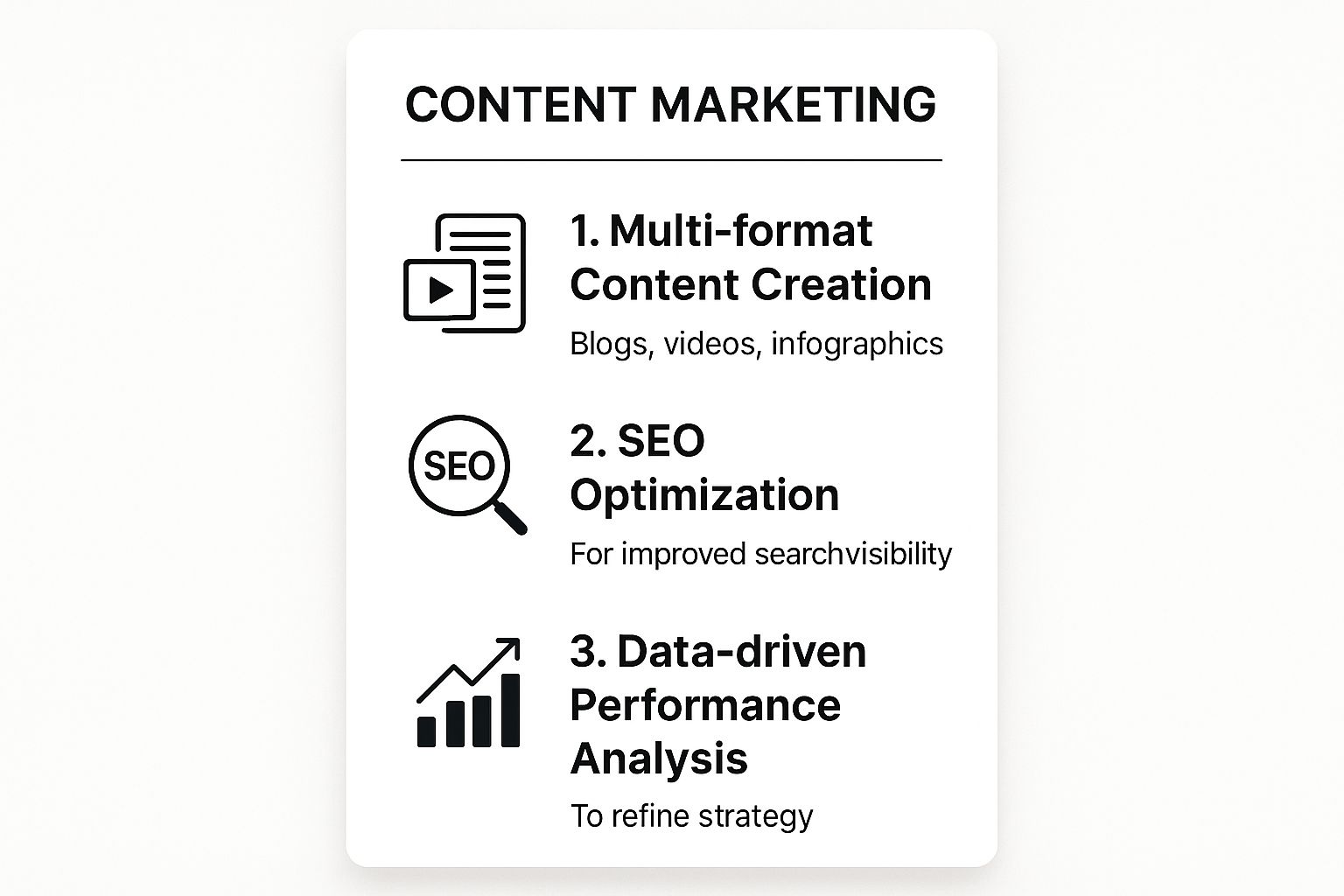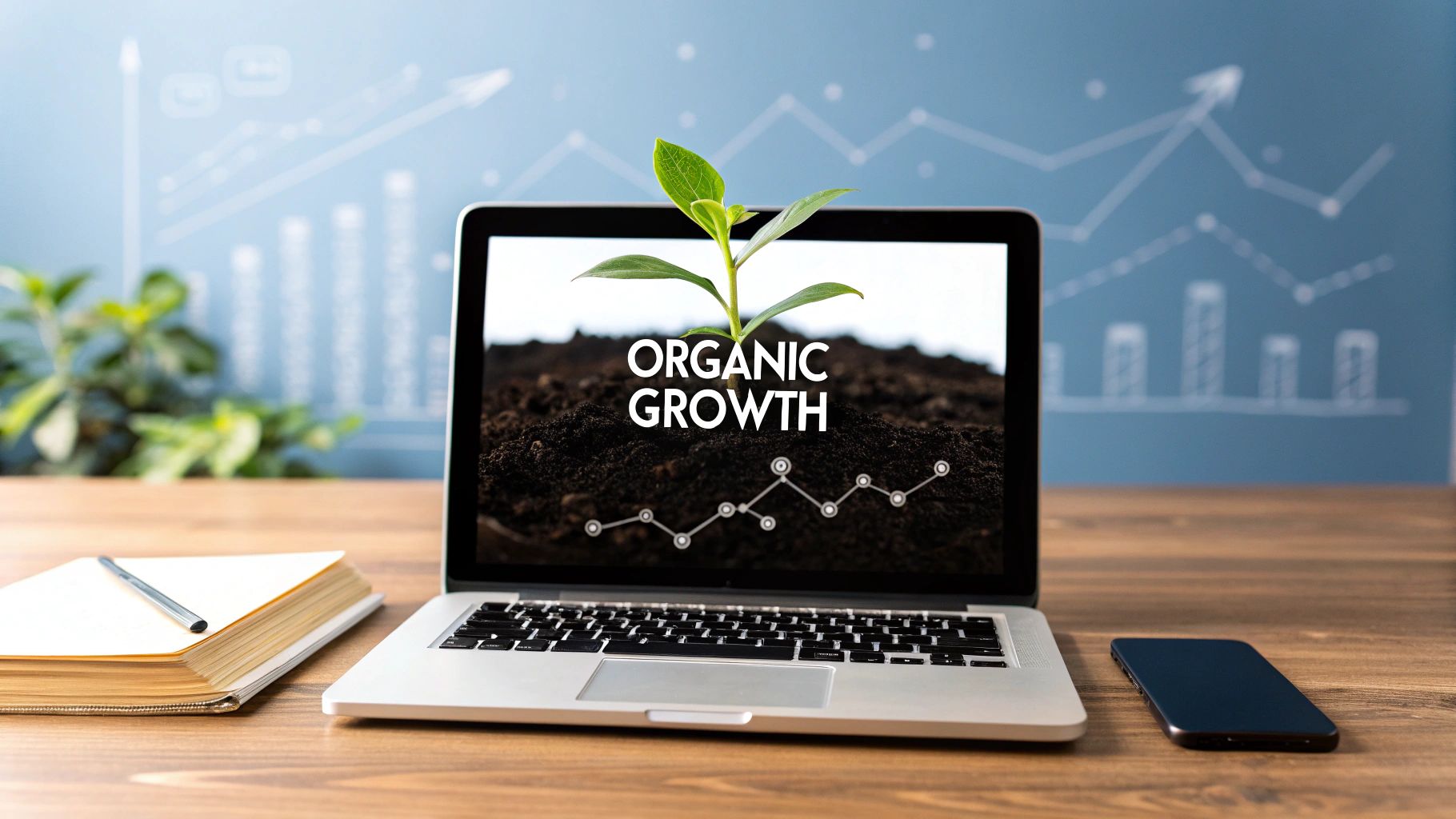In the competitive SaaS landscape, relying solely on paid acquisition is a race to the bottom. While ad spend can provide a temporary boost, sustainable, long-term success is built on a foundation of authentic connection and genuine value. This is where a robust set of organic growth strategies becomes your most powerful asset, creating a compounding effect that drives consistent traffic, builds brand authority, and fosters a loyal customer base without an ever-increasing budget.
Think of these strategies not as individual tactics, but as interconnected components of a resilient growth engine. They work together to attract, engage, and retain customers by delivering value at every stage of their journey. For SaaS companies, especially those in early stages or practicing product-led growth, mastering these methods is non-negotiable. It’s the difference between a business that perpetually pays for attention and one that earns it.
This article provides a blueprint for building that engine. We will unpack eight powerful organic growth strategies designed for the modern SaaS model. From leveraging content and SEO to turn your website into a lead-generation machine, to engineering referral programs that transform happy users into your most effective sales team, these are the proven tactics top companies use to scale intelligently. We'll move beyond the basics, offering actionable steps, real-world scenarios, and a clear roadmap for implementation. Get ready to build a system that runs on its own momentum, driving durable growth for years to come.
1. Content Marketing
Content marketing is one of the most foundational organic growth strategies available to SaaS companies. It moves beyond direct advertising to focus on creating and distributing valuable, relevant, and consistent content. The primary goal is to attract and retain a clearly defined audience, building trust and establishing your brand as a thought leader, which ultimately drives profitable customer action.
Instead of interrupting potential customers with a sales pitch, you provide them with resources that solve their problems, answer their questions, and help them succeed. This approach naturally pulls your ideal customer profile toward your brand. For example, HubSpot's extensive blog and free educational resources have made it a go-to authority in the marketing and sales space, generating millions of organic leads. Similarly, Shopify's detailed business guides empower aspiring entrepreneurs, directly aligning with its core product offering.
How to Implement a Content Marketing Strategy
A successful content marketing plan is strategic, not random. It requires understanding your audience's journey and creating targeted content for each stage.
- Develop a Content Calendar: Map your content to the customer journey (Awareness, Consideration, Decision). An Awareness stage blog post might be "7 Signs Your Team Needs a Project Management Tool," while a Decision stage piece could be a "Feature Comparison: [Your Product] vs. Competitor X."
- Focus on Customer Pain Points: Use customer interviews, support tickets, and sales feedback to identify the most pressing challenges your audience faces. Create content that directly addresses these issues. This is the core of Marcus Sheridan's "They Ask, You Answer" methodology.
- Repurpose and Distribute: A single comprehensive guide can be repurposed into a series of blog posts, an infographic, a webinar, social media snippets, and a video. This maximizes your effort and reaches different audience segments across various channels.
- Analyze and Optimize: Use analytics to track content performance. Identify which topics, formats, and channels drive the most traffic and conversions. Double down on what works and refine what doesn’t.
The following infographic highlights the core pillars of a modern content marketing engine.

As the visual summary shows, success hinges on a balanced cycle of creating diverse content, ensuring it's discoverable through SEO, and using data to inform your next steps.
For a deeper dive into building a content strategy from the ground up, this video from the Content Marketing Institute provides a fantastic overview.
2. Search Engine Optimization (SEO)
Search Engine Optimization (SEO) is a powerful set of organic growth strategies designed to increase a website's visibility in search engine results pages (SERPs). It involves optimizing your site's content, technical foundation, and authority to rank higher for keywords and phrases your target audience is searching for. Effective SEO ensures that when potential customers look for solutions, your brand is one of the first they find.

Unlike paid advertising, which stops working the moment you stop paying, SEO builds long-term, compounding value. It drives a continuous stream of qualified traffic by answering user queries and meeting their needs directly at the point of interest. For example, Canva dominates search results for design-related terms like "invitation maker" by creating optimized landing pages and tools. Similarly, Healthline has become a trusted source by providing medically reviewed articles that rank highly for a vast range of health questions.
How to Implement an SEO Strategy
A robust SEO strategy goes beyond simply adding keywords. It’s about creating a comprehensive experience that satisfies both users and search engine algorithms.
- Focus on User Intent: Prioritize understanding what a user is trying to accomplish with their search. Are they looking for information (informational intent), comparing options (commercial intent), or ready to buy (transactional intent)? Tailor your content to meet that specific need.
- Build Topic Clusters: Organize your content around core business themes. Create a central "pillar" page for a broad topic (e.g., "Project Management") and link it to more specific "cluster" posts (e.g., "Best Gantt Chart Software," "How to Run a Sprint Planning Meeting"). This structure signals expertise to search engines.
- Optimize for Modern Search: Go beyond traditional blue links. Target featured snippets, "People Also Ask" boxes, and voice search queries by providing clear, concise answers to common questions directly within your content.
- Conduct Regular Audits: SEO is not a "set it and forget it" task. Regularly audit your website for technical issues like slow page speed or broken links, and update existing content to keep it fresh and relevant. For those looking to deepen their understanding, exploring comprehensive SEO courses can provide a structured path to mastering visibility.
3. Social Media Marketing
Social media marketing is a powerful organic growth strategy that involves leveraging social platforms not just to broadcast messages, but to build communities and foster genuine relationships. It’s about engaging with your audience where they are most active, nurturing brand loyalty, and driving growth through authentic interaction rather than paid promotion. The goal is to create a strong brand presence that encourages conversation, user-generated content, and organic advocacy.

Unlike one-way advertising, organic social media is a dialogue. It allows you to build a brand personality that resonates with your target audience. For instance, Duolingo's viral TikTok content, featuring its mischievous owl mascot, has built a massive following by entertaining rather than selling. Similarly, Glossier built a cult following by featuring its community on Instagram and treating its customers like co-creators of the brand. This approach transforms followers from passive consumers into active brand participants.
How to Implement a Social Media Marketing Strategy
An effective organic social media plan is tailored to the unique culture of each platform and focuses on value-driven engagement, not just follower counts.
- Develop Platform-Specific Content: Don't just cross-post the same content everywhere. Create content that fits the context of each platform. For example, use LinkedIn for professional insights and case studies, Instagram for visually compelling stories and user-generated content, and TikTok for short, personality-driven videos.
- Engage Authentically and Proactively: Social media is a two-way street. Respond to comments and messages promptly and with personality. Use social listening tools to monitor mentions of your brand and industry keywords, allowing you to join relevant conversations and provide value even when you aren't tagged.
- Create Shareable Content: Design content that encourages participation. This could include interactive polls, questions that prompt discussion, or user-generated content campaigns. The goal is to create posts that users want to share with their own networks, expanding your reach organically.
- Leverage Trends Strategically: Pay attention to trending topics, memes, and audio on platforms like TikTok and X (formerly Twitter). Participating in these trends in a way that aligns with your brand voice can significantly boost your visibility and make your brand feel more relevant and human.
4. Email Marketing
Often underestimated in the age of social media, email marketing remains one of the most powerful and direct organic growth strategies. It involves building a list of subscribers and sending them targeted communications to nurture relationships, provide value, and drive conversions. Unlike other channels where algorithms control your reach, email gives you a direct line to your audience’s inbox.
The core principle is permission-based marketing. You aren’t interrupting strangers; you are communicating with people who have explicitly opted in to hear from you. This creates a high-engagement environment perfect for building loyalty. For instance, Morning Brew built a media empire on the back of a single, engaging daily newsletter. Similarly, Grammarly uses personalized writing insights and weekly stats to keep users engaged and highlight the product's value, reinforcing its utility long after the initial sign-up.
How to Implement an Email Marketing Strategy
A successful email strategy is built on trust and relevance, not just promotional blasts. It requires a systematic approach to segmenting your audience and delivering personalized value.
- Segment Your Lists: Group subscribers based on their behavior, lifecycle stage, or interests. For example, create segments for "New Trial Users," "Paying Customers," and "Inactive Users." This allows you to send highly relevant content, such as onboarding tips for new users or a re-engagement campaign for those who have lapsed.
- Write Compelling Subject Lines: Your subject line is the gatekeeper to your message. Use curiosity, urgency, or personalization to encourage opens. Test different approaches, like asking a question ("Struggling with team alignment?") versus a direct statement ("Your weekly performance report is here").
- Provide Consistent Value: Your emails shouldn't always be about selling. Mix in educational content, industry news, user success stories, and helpful tips. This builds a relationship where subscribers look forward to your emails, making them more receptive when you do present an offer.
- Optimize and Automate: Ensure your emails are mobile-friendly, as a significant portion of your audience will read them on their phones. Set up automated workflows (drip campaigns) for key actions like new sign-ups or cart abandonment to nurture leads efficiently and at scale.
5. Referral Programs
Referral programs are a powerful form of word-of-mouth marketing and one of the most effective organic growth strategies for SaaS. This approach systematizes customer advocacy by incentivizing existing users to recommend your product to their friends, colleagues, and professional network. It leverages the inherent trust people have in recommendations from those they know, turning your happy customers into a proactive acquisition channel.
Instead of paying for ads, you reward users directly for bringing in new business. This creates a virtuous cycle where satisfied customers attract more high-quality leads, who are often more loyal and have a higher lifetime value. Dropbox famously used this model, offering extra storage space to both the referrer and the new user, which contributed to its explosive early growth. Similarly, Airbnb's dual-sided referral program, which gives travel credit to both parties, has been a cornerstone of its global expansion.
How to Implement a Referral Program Strategy
A successful referral program feels like a natural extension of the user experience, not a forced marketing campaign. It should be simple, rewarding, and easy to find.
- Make the Referral Process Effortless: The process should be intuitive and require minimal clicks. Provide users with a unique, easy-to-copy referral link and pre-populated messages for email and social sharing. The fewer steps involved, the higher the participation rate.
- Offer Valuable, Aligned Incentives: The reward must be compelling enough to motivate action. For SaaS, this often means product-related perks like feature upgrades, account credits, or extended trials. Dual-sided incentives, where both the referrer and the new user benefit, are particularly effective as they make the referrer feel like they are giving a gift.
- Promote the Program In-App and Across Channels: Don't hide your referral program. Promote it within your application, in email newsletters, on post-purchase thank you pages, and through your customer support interactions. Visibility is crucial for driving engagement.
- Track, Analyze, and Personalize: Use analytics to monitor key metrics like participation rate, share rate, and conversion rate. Identify your top referrers and consider offering them exclusive rewards. Personalize referral communications to make the experience feel more genuine and less transactional.
By creating a structured system for recommendations, you can harness the enthusiasm of your user base to drive scalable, cost-effective growth.
To explore the nuances of setting up a program that drives real results, you can learn more about how to create a referral program on refgrow.com.
6. Strategic Partnerships
Strategic partnerships are powerful organic growth strategies where non-competing businesses collaborate to leverage each other's audiences, resources, and credibility. Instead of building an audience from scratch, you tap into an existing, relevant customer base, creating a win-win scenario that accelerates growth for both parties. This strategy moves beyond simple promotion to create genuine value for customers.

For instance, the integration between Spotify and Uber allows riders to control the music during their trip, enhancing the customer experience for both services. Similarly, Microsoft and Adobe have partnered to integrate their enterprise software, providing a more seamless workflow for their shared business customers. These collaborations introduce brands to new users in a contextually relevant and valuable way.
How to Implement a Strategic Partnership
A successful partnership is built on a foundation of shared goals, mutual trust, and clear communication. It's about finding the right fit and executing a plan that benefits everyone involved.
- Identify Complementary Partners: Look for businesses whose products or services are used by your ideal customer profile but are not direct competitors. Your customer’s tech stack is a great place to start. For example, a project management tool might partner with a time-tracking app.
- Establish Clear Goals and Metrics: Define what success looks like from the outset. Is the goal lead generation, brand awareness, or user acquisition? Set specific, measurable KPIs, such as "generate 100 qualified leads from co-marketing webinar" or "drive 500 new sign-ups through the partner integration."
- Create a Formal Agreement: Outline the responsibilities, timelines, resources, and success metrics for both parties in a formal agreement. This ensures alignment and prevents misunderstandings down the line.
- Co-Create and Co-Promote: Work together on the initiative, whether it's a joint webinar, a co-authored ebook, a product integration, or a cross-promotional campaign. Both partners should commit to promoting the initiative to their respective audiences to maximize reach.
For businesses looking to formalize their partner programs with performance-based incentives, exploring different partnership models is key. You can learn more about setting up a successful SaaS affiliate marketing program, which is a specific type of strategic partnership.
7. Customer Experience Optimization
While many organic growth strategies focus on attracting new customers, Customer Experience (CX) Optimization centers on retaining and delighting the ones you already have. It is the strategic process of improving every interaction a customer has with your brand, from their first website visit to their ongoing use of your product and support requests. The goal is to create a consistently seamless, positive, and memorable journey that fosters deep loyalty and turns customers into vocal advocates.
In the competitive SaaS landscape, a superior product is no longer enough. A delightful experience is a powerful differentiator that drives organic growth through reduced churn and increased word-of-mouth referrals. For instance, Zappos built an empire not just on selling shoes, but on a legendary customer service culture that empowers representatives to do whatever it takes to make a customer happy. Similarly, Apple’s seamless integration across its hardware, software, and retail experiences creates an ecosystem that is famously difficult for customers to leave.
How to Implement Customer Experience Optimization
A world-class customer experience is built intentionally, not accidentally. It requires a company-wide commitment to viewing every decision through the lens of the customer.
- Map the Complete Customer Journey: Document every single touchpoint a customer has with your brand, from discovering your content and signing up for a trial to upgrading their plan and contacting support. Identify potential points of friction or frustration at each stage.
- Collect and Act on Customer Feedback: Proactively gather feedback through various channels like Net Promoter Score (NPS) surveys, in-app feedback forms, customer interviews, and support ticket analysis. The key is to close the loop by acting on this feedback and communicating the changes you’ve made.
- Invest in Employee Training and Empowerment: Your support and success teams are on the front lines of the customer experience. Equip them with the training, tools, and authority to solve customer problems quickly and effectively without needing to escalate every issue. An empowered employee can turn a negative experience into a positive one.
- Measure and Track Experience Metrics: You can't improve what you don't measure. Track key CX metrics like Customer Satisfaction (CSAT), Churn Rate, Customer Lifetime Value (CLV), and Net Promoter Score (NPS). Use this data to identify trends and pinpoint areas for improvement.
8. Product Development and Innovation
While many organic growth strategies focus on external marketing and sales efforts, one of the most powerful levers for growth is internal: your product itself. Product development and innovation involve the continuous process of creating new features, improving existing solutions, and enhancing the overall user experience to meet evolving customer needs and market demands. This strategy drives sustainable growth by making your product stickier, more valuable, and inherently more shareable.
Instead of solely relying on marketing to attract users, you build a product that markets itself through its excellence. Think of how Slack continuously added features like threaded conversations, app integrations, and Huddles to become the indispensable communication hub for modern teams. Similarly, Tesla's relentless innovation in battery technology, autonomous driving features, and over-the-air software updates creates immense customer loyalty and brand advocacy, fuelling organic demand.
How to Implement a Product-Led Innovation Strategy
A successful innovation pipeline is driven by customer feedback and market awareness, not just internal brainstorming. It requires a disciplined approach to identifying opportunities and executing on them efficiently.
- Establish Robust Feedback Loops: Actively solicit and analyze user feedback from all channels: support tickets, customer interviews, in-app surveys, and community forums. Use this data to create a "Voice of the Customer" report that directly informs your product roadmap.
- Embrace Agile Methodologies: Use development frameworks like Scrum or Kanban to work in short, iterative cycles. This allows your team to build, test, and release features quickly, gathering real-world data to guide the next iteration rather than investing heavily in unproven ideas.
- Prioritize Ruthlessly: You can't build everything. Use a prioritization framework like RICE (Reach, Impact, Confidence, Effort) to score potential features. This ensures you focus development resources on initiatives that deliver the most significant value to both the user and the business.
- Balance Innovation with Viability: Ground your most ambitious ideas in market reality. Before committing to a major new feature, validate the concept with a small group of target customers. Ensure there is a genuine need and a willingness to adopt the solution you plan to build.
This approach is the cornerstone of a product-led growth model, where user acquisition, expansion, and retention are all driven by the product itself. For a complete guide on how to implement this model, explore our in-depth article on developing a product-led growth strategy.
Organic Growth Strategies Comparison Matrix
| Strategy | Implementation Complexity 🔄 | Resource Requirements ⚡ | Expected Outcomes 📊 | Ideal Use Cases 💡 | Key Advantages ⭐ |
|---|---|---|---|---|---|
| Content Marketing | Medium to High | High (content creation, SEO, analytics) | Builds long-term authority, organic traffic growth | Brand building, thought leadership, lead nurturing | Cost-effective, SEO improvement, reusable assets |
| Search Engine Optimization (SEO) | High | Moderate to High (technical & content) | Sustainable organic traffic, improved search rankings | Websites aiming for long-term organic visibility | High-intent users, measurable ROI |
| Social Media Marketing | Medium | Medium to High (content & engagement) | Increased brand awareness, direct customer engagement | Brand personality, viral reach, community building | Real-time feedback, viral potential |
| Email Marketing | Medium | Medium (list management, automation) | High ROI, personalized communication | Lead nurturing, conversions, customer retention | Highly measurable, scalable, direct channel |
| Referral Programs | Medium | Low to Medium (tracking & rewards) | Lower CAC, higher quality leads via word-of-mouth | Customer acquisition, loyalty boost | Cost-efficient, scalable growth |
| Strategic Partnerships | High | Medium to High (coordination & legal) | Access to new markets, shared resources | Market expansion, co-marketing, joint ventures | Shared costs, enhanced credibility |
| Customer Experience Optimization | High | High (systems, training, cross-team) | Increased retention, loyalty, advocacy | Brands focusing on seamless customer journeys | Competitive differentiation, reduced service costs |
| Product Development and Innovation | High | High (R&D, prototyping, testing) | New revenue streams, competitive advantage | Companies needing continuous innovation | Drives growth, brand reputation |
Integrating Your Strategies into a Unified Growth Engine
The journey through the landscape of organic growth strategies reveals a powerful truth: individual tactics, while potent, achieve their maximum impact when they work in concert. We've explored the foundational pillars, from crafting compelling content and mastering SEO to building vibrant communities on social media and nurturing leads through email. We've also delved into leveraging the voice of your customer through referral programs and optimizing their journey for retention and advocacy.
The real challenge, and the greatest opportunity, lies not in executing these strategies in separate silos, but in weaving them into a cohesive, self-reinforcing system. Think of it not as a checklist to complete, but as a blueprint for a dynamic growth engine.
From Silos to a Synergistic Flywheel
A common pitfall for many SaaS startups is treating each organic channel as a separate department with separate goals. The content team creates blog posts, the SEO team optimizes keywords, and the product team works on user experience, all with minimal interaction. This fragmented approach creates friction and misses out on massive compounding returns.
The key is to build connections that create a flywheel effect. Here’s how the pieces you've learned about fit together:
- Content and SEO: Your high-value content marketing efforts directly fuel your SEO. Every insightful blog post, detailed guide, or helpful tutorial you publish is another asset for Google to index, another opportunity to rank for critical keywords, and another reason for other sites to link back to you.
- SEO and Customer Experience: SEO doesn't just bring traffic; it brings qualified traffic. When users land on your site from a specific search query, your customer experience and product design must immediately validate their choice. A seamless onboarding flow and intuitive UI, as discussed in customer experience optimization, are crucial for converting that hard-won organic traffic into active users.
- Customer Experience and Referrals: An exceptional customer experience is the single most important ingredient for a successful referral program. When users are delighted with your product and feel supported, they don't just stay, they become evangelists. This turns your happy customers into your most authentic and effective sales force.
- Referrals and Social Media: A robust referral program naturally spills over into social media. Excited users share their referral links on Twitter, LinkedIn, or in private communities, providing powerful social proof that is far more convincing than any corporate advertisement. This amplifies your reach and feeds a new wave of potential customers back into your funnel.
Activating Your Growth Engine: Your Next Steps
Understanding this interplay is the first step. The next is to take decisive action. Don't feel overwhelmed by the need to implement everything at once. Instead, adopt a strategic, phased approach to building out your organic growth strategies.
- Conduct a Growth Audit: Start by assessing your current state. Where are your biggest gaps? Are you creating great content that no one can find? Is your SEO strong, but your product's user experience causing high churn? Identify the one or two areas that will have the most immediate impact.
- Prioritize an "Anchor" Strategy: Choose one core strategy to build around first. For many product-led SaaS companies, this is often a tie between Content Marketing and Customer Experience Optimization. These two pillars provide the foundation for nearly all other organic efforts.
- Forge the First Connection: Actively link your first two chosen strategies. If you focus on content and SEO, ensure your content calendar is driven by rigorous keyword research. If you focus on customer experience and referrals, embed your referral prompts at moments of peak user delight within the product journey.
- Integrate Smart Tools: Manually managing these interconnected systems is inefficient and prone to error. Leverage modern tools that are built for integration. This is especially true for high-leverage activities like referral marketing. A tool that embeds directly into your product removes friction and makes participation effortless for your users, dramatically increasing uptake.
Ultimately, mastering these organic growth strategies is about building a sustainable, resilient business. While paid acquisition can provide quick bursts of growth, it's a tap that runs dry the moment you stop paying. An organic growth engine, once running, builds momentum over time, generating high-quality leads, loyal customers, and a powerful brand reputation that becomes your most valuable asset.
Ready to ignite the most powerful part of your organic flywheel? Refgrow makes it simple to launch a sophisticated referral and affiliate program directly inside your SaaS product. Instead of complex, custom-coded solutions, you can embed a fully-featured program with a single line of code, turning your happiest customers into your most effective growth channel. See how you can accelerate your organic growth strategies by visiting Refgrow today.

